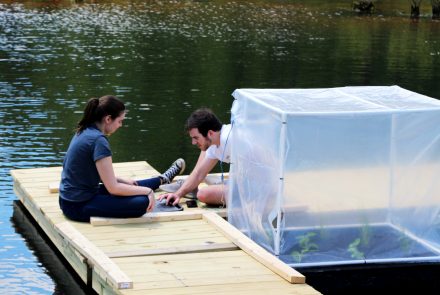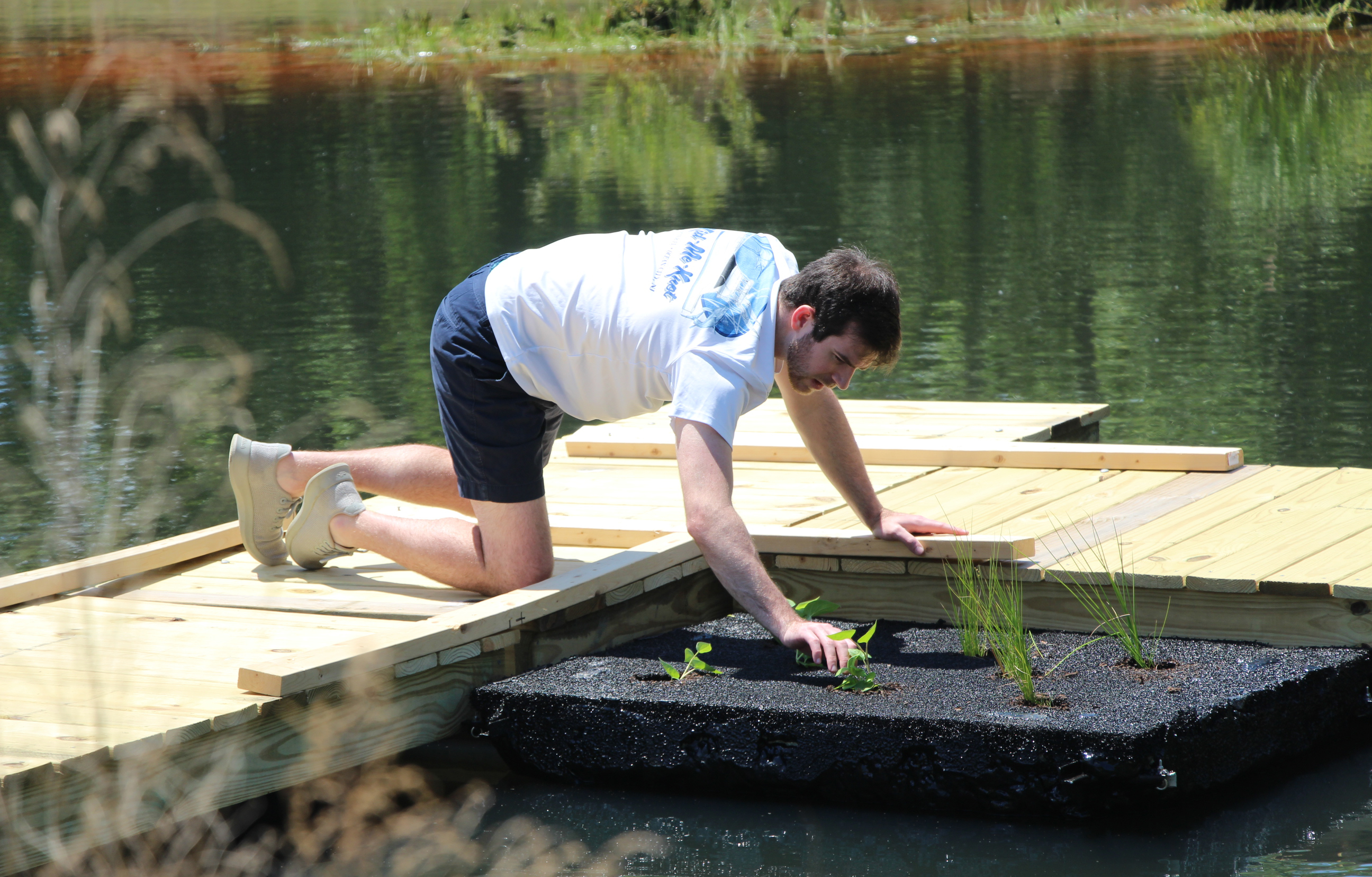Looking to the future of clean water, senior engineers develop floating constructed wetlands and water-quality sensors in a senior capstone project. A gift from the Meier family of Portland, Oregon, launched the ongoing water research project.
As the Innovation Quad takes shape near McMichael Science Center, another hub of engineering ingenuity has emerged in an unlikely place on Elon’s campus.
Tucked behind Schar Center in a stormwater drainage retention pond, 10 engineering seniors spent the final weeks of their last semester this spring constructing a dock and deploying floating constructed wetlands modules. From those 4-foot modules, they tested the results of a year’s worth of lab-bound labor: a series of sophisticated sensors economically designed to measure water quality paired with native plants that thrive on the excess nutrients in runoff. Elon’s second senior engineering capstone design project opens the door to real-time water quality monitoring, stormwater restoration and future projects that will advance water research.

The wetlands restoration capstone project was made possible through a generous gift by the Meier family of Portland, Oregon. Elon parent Eric Meier P’21 is a member and current chair of the university’s Engineering Advisory Board and said his family’s gift was made in hopes of developing Elon as one of the world’s leading schools for studying and solving water issues. The gift also created a significant Elon Experience, which is one of the priorities of the Elon LEADS campaign.
“Our hope is that the capstone will raise the curiosity of students to establish a career addressing water issues, which are pervasive,” said Meier, who holds an engineering degree from Duke University and is president and CEO of Owl Insights, a developer of software that helps manage behavioral health care conditions. “There is a real sense that we need to train the next generation of engineers to pursue a career in water science. I see it as a cross-functionality discipline. It encompasses the environment, technology, engineering capabilities, policy matters, regulations and other aspects.”
Meier said the capstone also fits Elon’s model of experiential learning.

“I thought, this is perfect for Elon and it has a great faculty to lead this important process. It’s a way for students to get their hands on and apply classroom learning to a project that’s definitely real world,” Meier said. “The capstone is a way for students to conceptualize, build, test and validate their hypothesis then take those learnings and apply it. It gives students a better sense of their future work in engineering.”
Gabie Smith, dean of Elon College, the College of Arts and Sciences, is grateful that Meier shares an ambitious vision for Elon’s engineering program. His commitment of time, financial support and professional expertise have already strengthened the program and student outcomes, she said.
“Eric has been an advocate for engineering since joining the Engineering Advisory Board when our program launched,” Smith said. “He has been instrumental in guiding the growth and development of our engineering program, taking on leadership of the Engineering Advisory Board and partnering with members to advance student outcomes. Moreover, the Meier family sponsorship of the constructed wetlands project creates deep experiential learning opportunities for our senior engineering students.”
Foundation for research

The Meier family’s capstone gift was instrumental not just in creating a valuable experience for the class of 2021, but in providing the foundation for research and design that will develop over years to come at the Innovation Quad, said Associate Professor of Engineering Scott Wolter. Wolter oversaw the capstone project with Assistant Professor of Engineering Jonathan Su and Professor of Biology and Environmental Studies Brant Touchette.
“This year’s project was significant because it advanced our interest in global and community outreach and our focus on becoming a water research center,” Wolter said “It gets all of that underway. The Meier family’s support moved us much farther ahead than we would have been able to go otherwise.”

Development threatens global water supplies by polluting water with excess nitrogen, phosphorous and other chemicals in fuels and fertilizers. That pollution leads to algae blooms and other conditions that kill wildlife and contaminate drinking water. Environmental engineering and water studies will be an important part of the Innovation Quad.
In August 2020, students were tasked with developing three kinds of computerized sensors — gas, electrochemical and optical — to measure nitrogen oxide, carbon dioxide, and other compounds and organisms in water or released by aquatic plants. They worked with Touchette to identify native wetland plants that break down and thrive on excess nutrients to plant in the floating modules.

Affordability is an obstacle to water quality monitoring and restoration. Designing economical alternatives to commercially available devices was a project goal from the outset, Wolter said. In one remarkable outcome, students began with a $10,000 system and designed an alternative prototype for less than $125. The underwater sensor developed by Noah Kagan ’21, Chloe Radigan ’21 and Morgan Sperry ’21 measures oxygen levels in water — a key factor in water system’s health. The more oxygen dissolved throughout water, the more able bacteria are to break down waste and contaminants.
Trent Houpt ’21 likened the floating wetlands project to a professional experience because it required ongoing research and design balanced with teamwork and deadlines.
“When I think about the internships I’ve had, this project has been more like an experience you would get on a job out in the field, and it’s great for us as students to get that experience before we graduate,” Houpt said.
Teamwork yields results

Houpt was part of the four-student team — with Georgia Gurney ’21, Alex Sobel ’21 and Charlie Walsh ’21 — that engineered and programmed sensors to measure methane and carbon dioxide released by plants on the modules. They also prototyped a module covering to collect the gases and house the sensor. Their sensor prototypes cost about $25 and perform comparably to $600 commercial sensors.
The third team of Matthew Del Valle ’21, Eduardo Gonzalez ’21 and Sohan Hess ’21 developed an innovative camera that uses a digital sensor rather than a lens to visualize particles beneath the water’s surface. Their complex design uses ultra-bright LED lights and an Arduino program to allow scientists to view specific types of bacteria or particulates in water. Their research found that lenses didn’t show microscopic particles clearly enough to identify pollutants.

“I think the one thing Elon consistently taught me is how to have an end-goal in mind and work toward it,” Del Valle said. “It took us months and months to get where we are, but you have to push through and not get frustrated. Eventually it will come together.
“It’s just a really cool project,” Del Valle continued. “We’re removing chemicals that are harming the environment and actually harming people, and we’re doing it without adding anything but native plants.”
A great experience for students

The wetlands project will continue into the 2021-22 academic year and beyond, with opportunities for progress and additional collaboration with faculty or outside partners. The seniors’ prototypes are easily replicated for future testing and refinement. Already, students working this summer have replicated the gas sensor and designed an additional sensor for more thorough readings. They will run tests and monitor the Schar Center pond in preparation for members of the Class of 2022 to begin the project’s next phases this fall. Advancing current designs, equipping wireless data transmission, testing the effectiveness of different vegetation, and experimenting with wetland module configurations are among many possible future projects as work continues.
“The Meiers have provided a great experience for our students by supporting them and the engineering program,” Wolter said. “It’s like a snowball. Now we’ve built up some speed and we’re growing.”
Eric Meier is the father of Lucie Meier ’21, who graduated in May with a degree in Communication Design. The family has previously supported the School of Education and Elon’s Greatest Needs.
“We really wanted to do something for the school,” Meier said. “My daughter loved her time at Elon. It’s been a life-changing experience for her.”

About the Elon LEADS Campaign
With a $250 million goal, Elon LEADS is the largest campaign in the university’s history and will support four main funding priorities: scholarships for graduates the world needs, increase access to engaged learning opportunities such as study abroad, research, internships and service learning, support for faculty and staff mentors who matter and Elon’s iconic campus. As of June 22, donors had contributed $213 million toward the goal.
Every gift to the university—including annual, endowment, capital, estate and other planned gifts—for any designation counts as a gift to the campaign, which will support students and strengthen Elon for generations to come. To learn more about how you can make an impact, visit www.elonleads.com.
Madison Taylor, development writer in the Office of University Advancement, contributed to this story.



